Visual Arts Review: Known and Mysterious—Wendy Artin’s Watercolors in “From the Roman Studio”
Wendy Artin finds beauty everywhere—in a clutch of beets, old paintbrushes, ruined statues, the human body—and then with wild generosity and utter mastery she offers them to us.
From the Roman Studio: Watercolor paintings by Wendy Artin. At Gurari Collections, 460 Harrison Avenue, Boston, MA, through December 6.
Finissage with Silent Auction of new work: Friday, December 4, from 6 to 9 p.m.
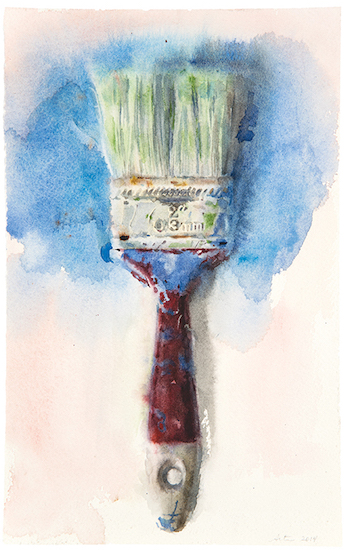
Wendy Artin, “Green Bristle Brush on Blue,” watercolor. Photo: Courtesy of Gurari Collections.
For Wendy Artin the moment where “marks click into illusion” is of utmost importance. With which brush stroke does the face emerge? When does that area of unpainted paper become background, and when does this one show itself as highlighted skin?
Such questions occur not only in the representational arts but all arts. When does melody erupt from a sequence of notes? When does a poem leave the plane of its origin to take its first turn? At what point does a fictional plot emerge from a collection of story elements? We don’t have to always be told why the queen died; if the beloved king has just died we can figure that out for ourselves. This seeking of coherence is one of the great elemental things we humans do—in all fields, and particularly in viewing art. Artin feels that it can be a mistake to push a painting too far beyond that first moment, when the brushstrokes evoke and become the form. She tries to keep the evidence of this hinging moment always in her finished work, inviting and allowing her viewers to participate in the process she has gone through.
Artin finds beauty everywhere—in a clutch of beets, old paintbrushes, ruined statues, the human body—and then with wild generosity and utter mastery she offers them to us. In her view nothing is too ordinary or too rare. The watercolors in her new show at Gurari Collections, From the Roman Studio, show us that everything is new and worthy of attention.
Paintbrushes
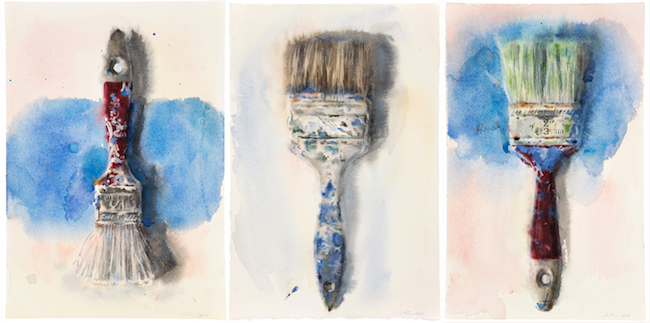
Wendy Artin, “Red Brush on Blue, Blue Brush, Green Bristled Brush on Blue,” watercolor. Photo: Courtesy of Gurari Collections.
Artin’s portraits of old paintbrushes are striking. With the technical brilliance of their textures and their sudden leap into polychrome, these brushes show their history and experience in much the same way as the human skin does. This is where I’ve been; this is what I’ve done; this is me. She sees these works as “a tribute to the beauty of aging and wear & tea—in paintbrushes, which, like city walls and statues, only improve with age.”
Artin makes these familiar domestic tools strange and mysterious, presenting usually unexamined instruments as things to consider seriously. To me they also appear as characters with sharp personalities. The one on the left, for example, I see as a somewhat ditzy young person in a sexy skirt with a hole where the brains should be; while for the two brushes on the right the bristles indicate the complexity of their brains, with ideas, images, and shadows spilling out onto the paper behind. Of course I’m reading too much into them, and I don’t think the artist would agree at all with my projections, but these brushes are no longer just brushes, and part of what Artin’s work forces us to do is to stop in our tracks and pay attention—to tools, to objects of the natural world, to made objects, and to her paintings themselves as another layer of made objects.
Besides, look at those bristles! Artin invites us to marvel at the invention of the brush—originally made of mammal hair, hog or badger, goat or sable, though now often of synthetic fibers. As a delivery system for blobs of pigment the brush is so much better than the finger, or the pointed stick, or even the quill, for in the brush, paint is carried by all the spaces between the hairs, as well as by the surface of each hair; by varying pressure and angle, the volume and texture of what is delivered can be infinitely varied and exquisitely controlled. Consider that first fox who dragged his tail in the wet carbon black of the calligrapher’s ink stone and then flicked its tip across the white mulberry paper.
Nudes
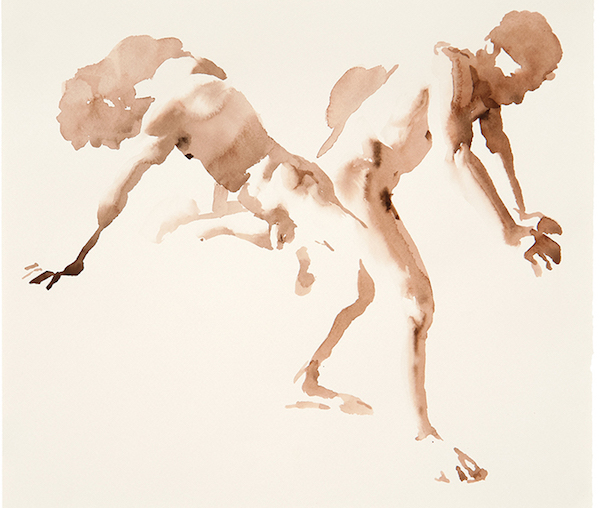
Wendy Artin, “Giuseppe Here and There,” watercolor. Photo: Courtesy of Gurari Collections.
Artin’s monochromatic nudes are powerfully kinaesthetic. As you gaze at them you can feel your own limbs edging toward their often unusual positions. These unclothed humans are always in conversation with their unfurnished surround, sepia/brown-madder brushstrokes flowing and occupying and nudging the whiteness of the paper.
Some of Artin’s nudes are quite small, and these tend to be the most abstract, with unpainted areas evoking both highlighted limbs and the background. Artin considers these white backgrounds not as unfurnished rooms, but as the matter from which her figures are formed, like the sculptor’s rough unhewn stone.
But some of the nudes here are unusually large for watercolors, essentially life-size. Face-to-face with them, for they are also exquisitely rendered portraits, we find they are ‘in our face,’ forcing a new dialogue between that nakedness which is our own, which we bring to the gallery with us underneath our layers of clothing, and the nudity of these beautiful strangers, sometimes inverted into a shoulder-stand, sometimes kneeling and torqueing, seeming to sway.
Classical Statues
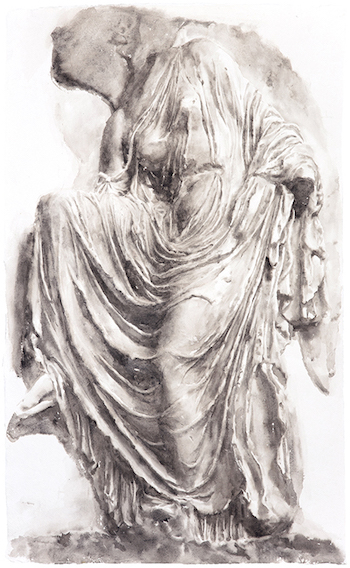
Wendy Artin, “Nike Adjusting her Sandal,” watercolor. Photo: Courtesy of Gurari Collections.
Artin is brilliant, too, at evoking the stones of classical antiquity (see The Arts Fuse piece, “Wendy Artin: Translating Marble onto Paper”). She says that these ruined sculptures appeal to her not only because of the presence of time and its erosions but also because the classical combination of naturalism and stylization feels similar to the mix of abstraction and figuration in her own work. Here we see how the painter’s gaze interprets and interacts with the sculptor’s intent and how watercolor, that most fluid and immediate of art forms, can capture and present what the stone carver and the passage of time and weather and other accidents have worked on a piece of stone. And always we see the flicking and puddling of the monochromatic liquid, the way it is sucked up and spread by the soft paper.
Although Artin most often paints ancient bas reliefs, a few of the pieces in this show are of sculptures in the round, as in her studies of the Belvedere Torso. Here the immense bulk of matter leaps out of the plane of the paper, exclaiming, I am a huge chunk of carved stone, which we believe until our gaze hits one of the swirls where the fluid paint has pooled and it reminds us that no, it is a watercolor.
Still Lifes
A clementine with stem and leaves attached hovers in the milkglass atmosphere, almost spinning, ornithoptering. Delicate tangerine reflections on the underside of a leaf add to our belief in its vivid reality.
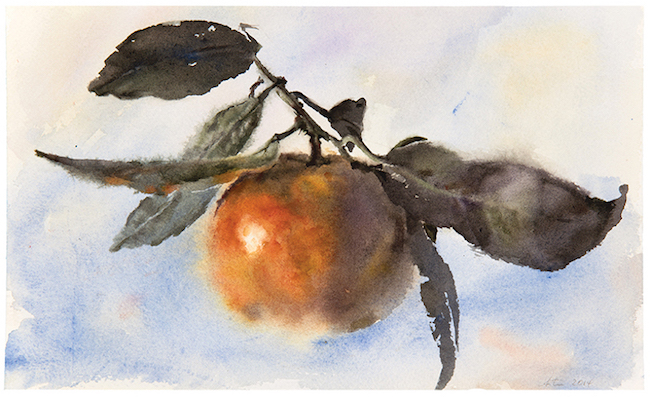
Wendy Artin, “Floating Clementine,” watercolor. Photo: Courtesy of Gurari Collections.
Artin as painter is constantly hinging between creator and viewer, the maker of marks, the spectator of illusion. Although all creators do this, and were doing it all the way back, in the beginning, Artin wants to bring us along with her, experiencing with her that transcendent oscillation between abstraction and focus, pigment and form.
Grace Dane Mazur is the author of HINGES: Meditations on the Portals of the Imagination; Trespass: A Novel; and Silk: Stories. She has been fiction editor at Tupelo Press and at Harvard Review. Most recently she has been on the fiction faculty of the MFA Program for Writers at Warren Wilson College; she has also taught at Harvard Extension School and Emerson College.
Tagged: Boston Gurari Collections, Roman Studio: Watercolor paintings by Wendy Artin
